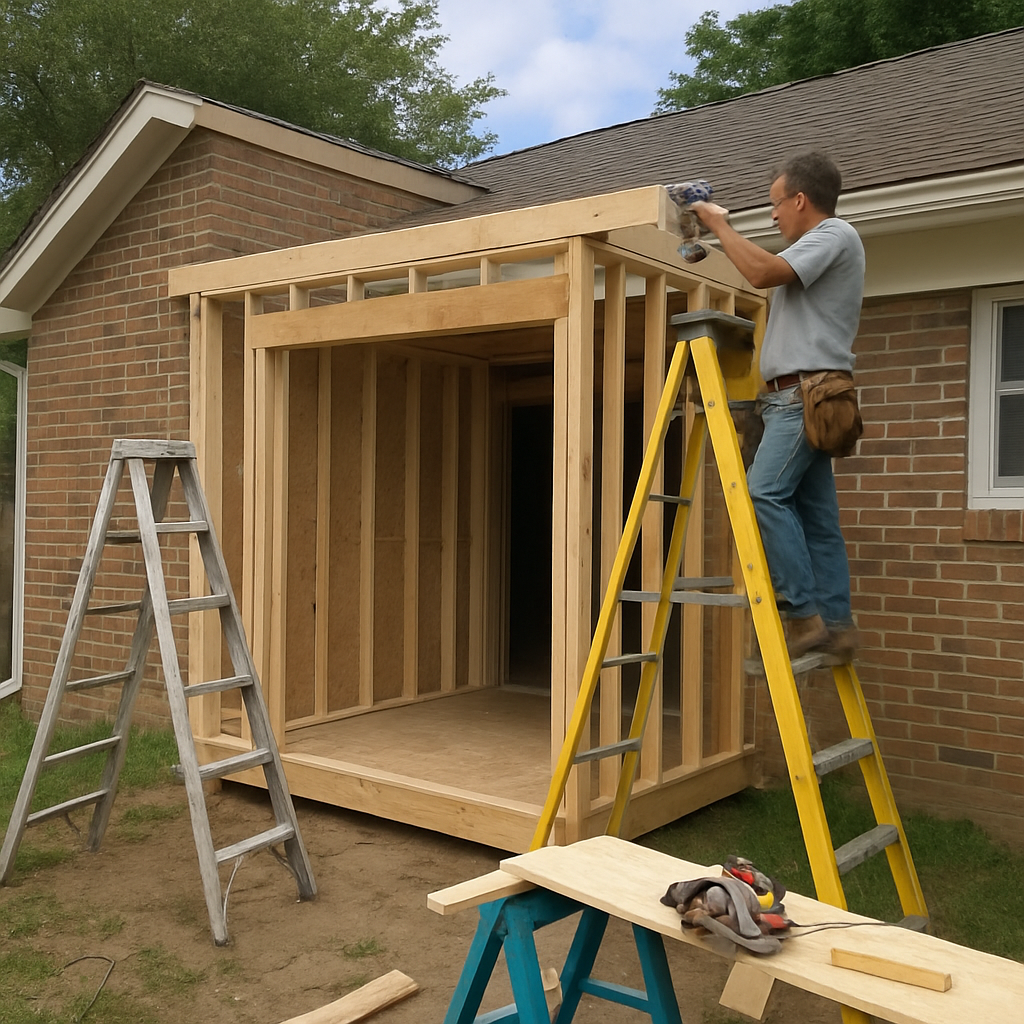In this guide, we’ll explore cost-effective ways to plan and execute a home addition. We’ll share practical tips and insights to help you make informed decisions and stretch your budget further. From understanding your needs to managing costs during construction, we’ll cover every aspet of the process. By the end of this guide, you’ll be equipped with the knowledge to tackle your home addition project efficiently and economically, ensuring a smooth and successful experience.

Once you have a clear understanding of your needs, consider how the addition will integrate with the existing structure. Will it complement the architectural style of your home, or will it require significant alterations? Thinking about these factors early on will prevent costly changes down the line. It’s also important to consider the long-term implications of your addition. How will it affect your home’s resale value, and does it align with neighborhood trends? By addressing these questions, you can ensure that your addition is not only functional but also a wise investment.
Setting a Realistic Budget
Creating a realistic budget is key to a successful home addition. Consider all potential costs, including design, materials, labor, and permits. It’s also wise to allocate a contingency fund for unexpected expenses. Research average costs in your area to ensure your budget is aligned with local prices. Start by gathering quotes from multiple contractors and suppliers to get a sense of the financial landscape. This will give you a benchmark to work from and help you identify areas where you can cut costs without compromising quality.
In addition to researching costs, consider your financing options. Will you be using savings, a home equity loan, or other financial resources? Understanding your financing options will help you determine how much you can realistically spend. Be sure to factor in any potential interest rates or repayment terms when planning your budget. By taking a comprehensive approach to budgeting, you can prevent financial strain and ensure a smooth project execution.
Cost-Effective Planning Tips
Prioritize Your Needs
When planning a budget home extension, prioritize your needs over wants. Focus on the essential features that will provide the most value and functionality. This will help you allocate funds more efficiently and prevent unnecessary expenses. Begin by listing all the features you desire in your addition and then categorize them into “must-haves” and “nice-to haves.” This exercise will help you focus on what truly matters and avoid getting sidetracked by less important details.
Once you’ve prioritized your needs, communicate them clearly to your contractor or designer. This will ensure that everyone involved in the project understands your goals and can work towards achieving them. Regularly revisit your priorities throughout the project to ensure you stay on track and within budget. Flexibility is key, but having a clear hierarchy of needs will guide your decision-making process and keep your project aligned with your financial capabilities.
Consider DIY Options

For those tasks that you do take on, invest time in researching best practices and gathering the necessary tools. There are plenty of online resources and tutorials available to guide you through various DIY tasks. Additionally, consider enlisting the help of friends or family members who have experience in construction or home improvement. This collaborative approach can make the process more enjoyable and further reduce costs.
Choose Cost-Effective Materials
Selecting budget friendly materials can significantly reduce costs. Opt for materials that offer durability and aesthetics without the high price tag For example, laminate flooring can mimic the look of hardwood at a fraction of the cost. Compare prices and explore alternatives to find the best options for your project. Consider visiting local suppliers or salvage yards for unique and affordable materials that can add character to your addition.
In addition to cost, consider the long term maintenance and sustainability of the materials you choose. Investing in materials that require less upkeep can save you money over time. Furthermore, selecting eco friendly options can reduce your environmental impact and potentially qualify you for tax incentives or rebates. By making informed choices about materials, you can achieve a beautiful and sustainable addition without overspending.
Planning and Design
Maximize Existing Space
Before building an addition, explore ways to maximize your existing space. Consider converting a basement, attic, or garage into usable living space. This can be a more affordable option than building a new structure from scratch. Begin by evaluating the potential of these areas and identifying any necessary modifications or improvements. This approach not only saves money but also minimizes the impact on your property’s footprint.
In addition to maximizing existing spaces, consider how you can optimize the layout of your home. Reconfiguring rooms or improving storage solutions can make your home feel larger and more functional. Work with a designer or architect to explore creative solutions that maximize space and enhance the overall flow of your home. By thinking outside the box, you can achieve your desired outcome without the need for extensive construction.
Simplify the Design
A simple, efficient design can help keep costs down. Avoid complex architectural features that require additional materials and labor. Work with a designer or architect to create a plan that meets your needs while staying within budget. Embrace minimalist design principles that prioritize functionality and simplicity. This approach not only reduces costs but also creates a timeless aesthetic that can adapt to changing trends.
When simplifying the design, focus on elements that offer the most impact. Thoughtful choices in layout, lighting, and materials can create a cohesive and inviting space. Collaborate with your designer to identify opportunities to streamline the design without sacrificing quality or style. By prioritizing simplicity, you can achieve a beautiful addition that stands the test of time.
Choose an Experienced Contractor
Hiring an experienced contractor is crucial for a successful home addition. Look for a contractor with a track record of completing projects on time and within budget. Get multiple quotes and check references to ensure you’re making an informed decision. Take the time to interview potential contractors and assess their communication skills, reliability, and understanding of your vision.
In addition to experience, consider the contractor’s familiarity with local building codes and regulations. A knowledgeable contractor can navigate the permitting process and ensure compliance with all necessary requirements. Establishing a positive working relationship with your contractor is essential for a smooth project. Clear communication and mutual respect will facilitate collaboration and help prevent misunderstandings or disputes.
Permits and Regulations
Understand Local Building Codes
Before starting your home addition, familiarize yourself with local building codes and regulations. Obtain the necessary permits and ensure your plans comply with zoning laws. Failing to do so can result in costly fines and delays. Begin by contacting your local building authority or visiting their website to gather information on the specific requirements for your area.
Understanding building codes is not only about compliance; it’s also about ensuring the safety and integrity of your addition. Codes are designed to protect homeowners and occupants, so adhering to them is crucial. Consider enlisting the help of a professional, such as an architect or contractor, to navigate the permitting process and ensure all documentation is in order. Being proactive in this regard can save you from potential headaches and legal issues down the line.
Plan for Inspections
Building inspections are typically required at various stages of construction. Plan for these inspections and work with your contractor to ensure your project meets all necessary requirements. This will help prevent costly rework and ensure a smooth process. Familiarize yourself with the inspection schedule and requirements to avoid any surprises.
In addition to planning for inspections, maintain open communication with inspectors and address any concerns promptly. By fostering a cooperative relationship with inspectors, you can ensure that your project proceeds smoothly and without delays. Understanding the inspection process and preparing accordingly will help you avoid potential setbacks and keep your project on track.
Managing Costs During Construction
Monitor Expenses Closely
Keep a close eye on expenses throughout the construction process. Regularly review invoices and track costs against your budget. Address any discrepancies immediately to avoid budget overruns. Implement a system for organizing receipts and invoices to maintain a clear record of all expenditures. Regularly comparing these records to your budget will help you identify any deviations or unexpected costs.
In addition to tracking expenses, consider implementing cost control measures such as negotiating with suppliers or exploring bulk purchasing options. These strategies can help you achieve savings without compromising quality. By staying vigilant and proactive, you can effectively manage costs and ensure your project remains within budget.
Communicate with Your Contractor
Maintain open communication with your contractor to stay informed about project progress and any potential issues. Discuss any changes to the plan and understand their impact on the budget. Collaboration and transparency are key to managing costs effectively. Establish regular check-ins or meetings to review progress and address any concerns promptly.
Encourage your contractor to provide updates and feedback throughout the project. This open dialogue will help you anticipate potential challenges and make informed decisions. By fostering a collaborative relationship with your contractor, you can work together to find solutions and achieve your desired outcome.
Make Informed Decisions
Throughout the project, you’ll need to make decisions that impact costs. Weigh the pros and cons of each choice and consider how it aligns with your overall budget. Be prepared to compromise on certain features to stay within your financial limits. Approach each decision with a clear understanding of your priorities and the potential implications.
In addition to considering costs, think about the long term benefits and drawbacks of each choice. Will a particular feature add value to your home, or is it a short-lived trend? By making informed decisions, you can ensure that your addition is both functional and financially sound.
Finishing Touches
Opt for Affordable Finishes
When it comes to finishes, such as paint, fixtures, and decor, there are plenty of affordable options available. Shop around and compare prices to find the best deals. Focus on quality and durability to ensure your investment lasts. Consider visiting discount stores or online marketplaces for unique and budget-friendly options that add style to your space.
In addition to affordability, consider how your chosen finishes will complement the overall design of your addition. Harmonizing finishes with the existing decor can create a cohesive and polished look. By making thoughtful choices in finishes, you can enhance the aesthetic appeal of your addition without overspending.
Add Personal Touches
Personal touches can enhance the overall look and feel of your addition without adding significant costs. Consider incorporating DIY decor, family photos, or unique accents that reflect your personality and style. These elements can create a warm and inviting atmosphere that makes the space feel truly your own.
In addition to personal decor, consider how you can use existing furniture or decor in your new addition. Repurposing items you already own can save money and reduce waste. By infusing your addition with personal touches, you can create a space that feels uniquely yours and adds value to your home.
Conclusion
Planning a home addition on a budget requires careful consideration and strategic decision making. By understanding your needs, setting a realistic budget, and implementing cost-effective strategies, you can achieve a beautiful and functional addition without financial stress. Remember to prioritize your needs, work with experienced professionals, and stay informed throughout the process. This proactive approach will ensure a successful outcome and help you avoid common pitfalls.
With the right approach, your dream home addition is within reach, and you can enjoy the benefits of an expanded living space without breaking the bank. By following the guidelines outlined in this guide, you can embark on your home addition journey with confidence and clarity. Happy planning!




